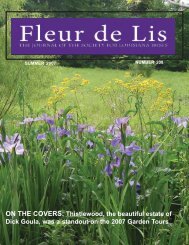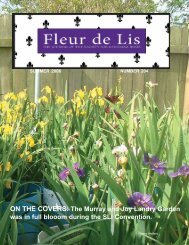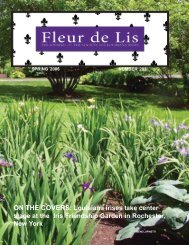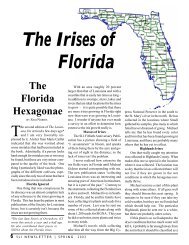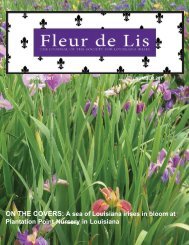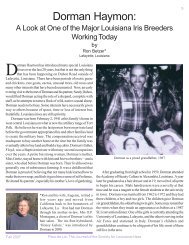Peter Jackson Expands Louisiana Iris Breeding in Australia
Peter Jackson Expands Louisiana Iris Breeding in Australia
Peter Jackson Expands Louisiana Iris Breeding in Australia
- No tags were found...
You also want an ePaper? Increase the reach of your titles
YUMPU automatically turns print PDFs into web optimized ePapers that Google loves.
as a “time of observation,” when he couldlearn to carefully evaluate seedl<strong>in</strong>gs. Heregistered and <strong>in</strong>troduced his first hybrids<strong>in</strong> 1997, ‘It’s Lilac Time,’ and ‘OaklandsJewel’.<strong>Jackson</strong> says he has gotten to thepo<strong>in</strong>t now that he plans his crosses verycarefully, <strong>in</strong> part simply due to space limitationsimposed by grow<strong>in</strong>g seedl<strong>in</strong>gs <strong>in</strong>pots.GoalsAmong his goals is “to produce a highquality red, a ruffled near black, and toexperiment with ve<strong>in</strong><strong>in</strong>g and spray patterns.”He has always been attracted tothe red <strong>Louisiana</strong>s, mention<strong>in</strong>g ‘AnnChown<strong>in</strong>g’ as a favorite, not<strong>in</strong>g, “I lovethe deep currant red and also the contrastof the bright gold triangular signals.”<strong>Peter</strong> has selected “the reddest LAthat has appeared <strong>in</strong> my seedl<strong>in</strong>g patch,”for further observation and ref<strong>in</strong>ement.This cross of ‘Lucy Payens’ x ‘GladiatorsGift’ is a bitone with bright red falls(which he admits need further work).The same cross produced a lower grow<strong>in</strong>giris of <strong>in</strong>tense yellow with heavy ruffl<strong>in</strong>gof strong substance, which mightbe <strong>in</strong>troduced later.<strong>Breed<strong>in</strong>g</strong> for red also produced‘Coonawarra Claret,’ one of <strong>Jackson</strong>’sguest irises that bloomed for the 2002Society convention <strong>in</strong> Little Rock. Introduced<strong>in</strong> 1999, ‘Coonawarra Claret’is a deep velvety w<strong>in</strong>e red, which contrastsnicely with cream style arms and adeep gold star signal. His near-blackbreed<strong>in</strong>g l<strong>in</strong>e has produced ‘Storm Boy’and ‘Iron Man,’ with several seedl<strong>in</strong>gsunder evaluation.‘Coonawarra Claret’ resulted froma cross of ‘Gladiator’s Gift’ x ‘DesertJewel.’ ‘Gladiator’s Gift’ (J. Taylor, 90)shows up aga<strong>in</strong> and aga<strong>in</strong> <strong>in</strong> <strong>Jackson</strong>’scrosses, as it does <strong>in</strong> much of the breed<strong>in</strong>gwork be<strong>in</strong>g done <strong>in</strong> <strong>Australia</strong> andmuch of the American west coast. Healso makes quite a lot of use of ‘LucyPayens’ (J. Taylor 92) as well as Taylor’sfamed ‘Margaret Lee’ (R91).The garden<strong>in</strong>g public has been quitetaken with two of <strong>Peter</strong>’s cultivars whichare not from his dark red breed<strong>in</strong>g. ‘It’sLilac Time’ (R. 97) is a very soft lavenderbitone with complementary creamand lilac style arms, and it is reported tohave a pleas<strong>in</strong>g fragrance. A deep rosep<strong>in</strong>k with an umbrella form, ‘Bright Parasol’(R99) sports a raised spear signal onall petals.Among <strong>Jackson</strong>’s favorite named<strong>Louisiana</strong> irises are the previously mentioned‘Ann Chown<strong>in</strong>g,’ and several <strong>in</strong>troductionsby fellow <strong>Australia</strong>ns, <strong>in</strong>clud<strong>in</strong>gHeather Pryor’s ‘Garnet StormDancer’ and ‘Venus Vortex,’ a deeppurple with a huge white spray patternthat <strong>Jackson</strong> proclaims “stunn<strong>in</strong>g—verydramatic!” He likes John Taylor’s ‘Undercover’(R 96), a dark violet, as wellas Taylor’s ‘Da<strong>in</strong>tree’ (R 97), a “beautifulbright yellow with great form and ruffl<strong>in</strong>g.”Compact Program<strong>Jackson</strong>’s breed<strong>in</strong>g program has beencarried on <strong>in</strong> a t<strong>in</strong>y back yard garden <strong>in</strong>Adelaide, the capital of South <strong>Australia</strong>.The <strong>Jackson</strong>s grow over 120 varieties of<strong>Louisiana</strong>s, plus his seedl<strong>in</strong>gs—all of thisdone <strong>in</strong> 500 pots. “People are amazedat what we can fit <strong>in</strong>to our back yard,but it’s a case of mak<strong>in</strong>g sure that everyth<strong>in</strong>gis <strong>in</strong> its place,” <strong>Jackson</strong> says.<strong>Jackson</strong> <strong>Iris</strong>es. From left, top, ‘EncounterBay’, which has just received an HCfrom the Victorian <strong>Iris</strong> Society <strong>in</strong> <strong>Australia</strong>;‘It’s Lilac Time’, among <strong>Peter</strong>’sfirst, a 1997 registration.Above, from top: ‘Storm Boy’, a deeppurple; ‘Burra Burra, a red-brown blendregistered <strong>in</strong> 2001; and the spectacularlyruffled, light lavender blue ‘QueenAdelaide’, registered <strong>in</strong> 2001.W I N T E R 2 0 0 2 | S L I N E W S L E T T E R 5



